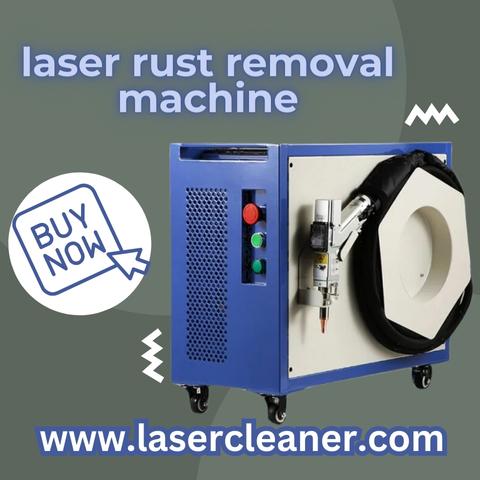Can a laser rust removal machine really replace traditional rust removal methods completely?

Rust has been a persistent enemy of metal surfaces for centuries, leading to corrosion, weakening structures, and ruining aesthetics. For decades, industries and individuals have relied on various methods—chemical treatments, sandblasting, grinding, and scraping—to get rid of rust. But what if a cutting-edge technology could tackle rust efficiently, precisely, and without the mess? Enter the laser rust removal machine.
What Is a Laser Rust Removal Machine?
At its core, a laser rust removal machine uses concentrated beams of light to remove rust from metal surfaces. Unlike conventional methods that often involve abrasive materials or harsh chemicals, this technology targets rust layers with pinpoint accuracy, vaporizing corrosion without damaging the underlying metal.
This isn’t just a gimmick. It’s a game-changer for industries like automotive restoration, shipbuilding, aerospace, and manufacturing, where maintaining metal integrity and appearance is crucial.
How Does a Laser Rust Removal Machine Work?
The process involves emitting high-intensity laser pulses on the rusted surface. The energy from the laser heats and vaporizes the rust particles, effectively separating them from the metal substrate. The laser parameters—such as power, pulse duration, and frequency—are adjustable to match the type and thickness of rust, as well as the metal beneath.
One major advantage is the non-contact nature of the process. Since the laser doesn’t physically touch the surface, there’s minimal risk of surface deformation or unwanted wear. Plus, the process is clean: it produces very little dust or debris compared to sandblasting or grinding.
Applications of Laser Rust Removal Machines
The versatility of laser rust removal machines means they’re useful across many sectors. Here are a few examples:
-
Automotive Restoration: Classic car restorers can remove rust precisely without harming fragile parts or old paint layers.
-
Ship Maintenance: Rust is a constant problem for ships due to saltwater exposure. Laser systems allow efficient cleaning without introducing moisture or chemicals.
-
Industrial Equipment: Machinery exposed to harsh environments can be cleaned to extend service life without downtime for chemical treatments.
-
Aerospace: Aircraft components demand precise cleaning to maintain safety and performance standards.
Environmental Impact and Safety
Traditional rust removal often involves chemicals that can harm the environment or require special disposal. The laser rust removal machine uses only light energy, making it a far cleaner option. Additionally, it eliminates the need for abrasive media that can pollute workspaces.
While lasers require safety protocols due to the intensity of the light, modern machines come with enclosures, sensors, and automatic shutoffs to protect operators.
Economic Impact of Using Laser Rust Removal
Although the initial investment for a laser rust removal machine might be higher than conventional tools, the operational cost savings can be significant. There is no need to purchase consumables like chemical solvents or abrasive powders, and cleanup time is reduced due to the minimal waste produced.
Moreover, because the machine can clean surfaces faster and with greater precision, companies experience less downtime, which translates to improved productivity and profitability.
Challenges with Traditional Rust Removal
Before laser technology became accessible, industries faced several challenges:
-
Labor-Intensive Methods: Sandblasting and manual scraping require extensive manpower and time.
-
Surface Damage: Abrasive techniques often damage the metal surface or alter dimensions.
-
Chemical Disposal: Rust removers contain acids or toxic solvents, requiring careful handling and environmental considerations.
-
Incomplete Removal: Sometimes rust is embedded in crevices where traditional tools can’t reach, leaving residual corrosion.
Laser rust removal machines overcome many of these problems by offering a more targeted and efficient cleaning method.
The Science Behind Laser Rust Removal
The effectiveness of laser rust removal lies in the difference in thermal properties between rust and metal. Rust, primarily iron oxide, absorbs laser energy more readily than the underlying steel or iron. When exposed to laser pulses, rust heats up rapidly and vaporizes before the metal heats enough to be damaged.
The laser’s wavelength and pulse duration can be fine-tuned to maximize rust removal while preserving metal quality. This selectivity is a major advantage over abrasive or chemical methods.
Future Trends in Rust Removal Technology
As laser technology advances, machines are becoming more compact, affordable, and user-friendly. Integration with robotic arms and automated systems allows for rust removal in hard-to-reach areas and large-scale industrial applications.
Additionally, ongoing research focuses on enhancing laser efficiency and developing hybrid systems combining lasers with other cleaning technologies for even better results.
Is Laser Rust Removal Right for You?
Whether you’re a professional restorer, a manufacturer, or a maintenance technician, the laser rust removal machine offers a compelling solution to one of the most persistent problems in metal maintenance. It combines precision, efficiency, and environmental friendliness in a way traditional methods simply can’t match.
Final Thoughts
The rise of the laser rust removal machine marks a significant leap forward in how we combat corrosion. It represents a fusion of science, engineering, and environmental responsibility, providing industries with a tool that’s both powerful and sustainable. While traditional methods have served well in the past, the laser approach opens new possibilities for preserving metal structures and equipment with unparalleled accuracy and care.
Embracing this technology means stepping into the future of rust removal—where clean surfaces, minimal waste, and operational efficiency are not just aspirations but everyday realities.
- Art
- Causes
- Crafts
- Dance
- Drinks
- Film
- Fitness
- Food
- Games
- Gardening
- Health
- Home
- Literature
- Music
- Networking
- Other
- Party
- Religion
- Shopping
- Sports
- Theater
- Wellness


